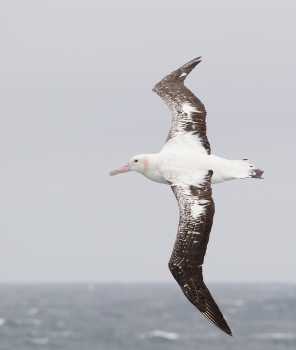Lucas Krüger (Marine and Environmental Science Centre, Department of Life Sciences, University of Coimbra, Coimbra, Portugal) and colleagues have published in the journal Animal Conservation on using the at-sea seasonal distribution of 14 procellariform seabird species to choose pelagic MPAs in the in the south-west Atlantic.
“With increasing pressure on the oceans from environmental change, there has been a global call for improved protection of marine ecosystems through the implementation of marine protected areas (MPAs). Here, we used species distribution modelling (SDM) of tracking data from 14 seabird species to identify key marine areas in the southwest Atlantic Ocean, valuing areas based on seabird species occurrence, seasonality and extinction risk. We also compared overlaps between the outputs generated by the SDM and layers representing important human threats (fishing intensity, ship density, plastic and oil pollution, ocean acidification), and calculated loss in conservation value using fishing and ship density as cost layers. The key marine areas were located on the southern Patagonian Shelf, overlapping extensively with areas of high fishing activity, and did not change seasonally, while seasonal areas were located off south and southeast Brazil and overlapped with areas of high plastic pollution and ocean acidification. Non-seasonal key areas were located off northeast Brazil on an area of high biodiversity, and with relatively low human impacts. We found support for the use of seasonal areas depending on the seabird assemblage used, because there was a loss in conservation value for the seasonal compared to the non-seasonal approach when using ‘cost’ layers. Our approach, accounting for seasonal changes in seabird assemblages and their risk of extinction, identified additional candidate areas for incorporation in the network of pelagic MPAs.”

Wandering Albatross - one of the studied species, photograph by John Chardine
Reference:
Krüger, L., Ramos , J.A., Xavier, J.C., Grémillet , D. González-Solıs, J. Kolbeinsson , Y. Militão, T., Navarro , J. Petry, M.V., Phillips, R.A., Ramírez, I., Reyes-González , J.M., Ryan, P.G., Sigurðsson, I.A., Van Sebille, E., Wanless, R.M. & Paiva, V.H. 2017. Identification of candidate pelagic marine protected areas through a seabird seasonal-, multispecific- and extinction risk-based approach. Animal Conservation doi:10.1111/acv.12339.
John Cooper, ACAP Information Officer, 28 February 2017

 English
English  Français
Français  Español
Español